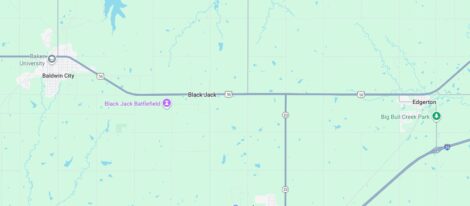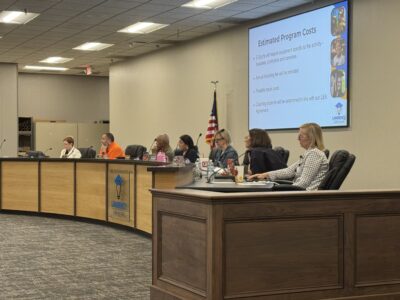Douglas County commissioners consider setting aside $1M for crisis care while delaying Bert Nash decisions

photo by: Josie Heimsoth/Journal-World
Douglas County commissioners met for deliberations on the 2026 budget on Tuesday, July 15, 2025.
Douglas County commissioners are potentially planning to reserve $1 million for mental health crisis care in 2026, while delaying some funding decisions for Bert Nash Community Mental Health Center amid financial concerns.
During budget deliberations on Tuesday, county commissioners wanted to address the rising costs for services at the Treatment & Recovery Center, but were hesitant to fund several additional funding requests from Bert Nash while the organization tackles financial challenges. To address an anticipated need, commissioners are planning to set aside $1 million in contingency funds for mental health crisis system operations.
But the $1 million will not just be limited to the TRC, but will be available to other organizations needing support for crisis care, such as HeadQuarters Kansas, which runs 24/7 crisis services via the 988 Lifeline and local lines – and has also struggled financially in the last year.
Before commissioners will award additional funding to Bert Nash, the Commission wants to meet with the governing board to get a better understanding of the financial situation, and then provide assistance where it is most needed.
Commissioner Patrick Kelly opened discussions around Bert Nash saying he wasn’t comfortable in providing additional funding to the Treatment & Recovery Center in 2026 – totaling over $1.2 million – because of all the changes that have occurred at the organization, such as a recent change in leadership.
“At this time, I just don’t feel like we have a real solid grasp on this number,” Kelly said.
Willey agreed and said she didn’t have any financials from Bert Nash “that I could hang my hat on, and that’s a really sticky place to be for such a big partner.”
Bert Nash has submitted three separate additional funding requests to county commissioners in this budget cycle. One is requesting $500,000 in gap funding to address the challenges to its behavioral health services, specifically outpatient therapy services. There are also two other requests for the Treatment & Recovery Center, with $604,305 in 2025 and $1,249,424 next year.
However, in addition to the $1 million for crisis care across organizations, commissioners are considering setting aside $500,000 in solvency funding for Bert Nash. Commissioner Karen Willey said filling operational gaps is not an interest, but the funds would be used to make operations more efficient down the road.
“As we flesh out those conversations through the year, I don’t know if we would be open in paying the entirety of any of those things … It would be a conversation with their board about how are they stepping up and what’s changing.”
Meanwhile, another organization, HeadQuarters Kansas has also submitted two new funding requests to help with past expenses for 2024 and 2025. Also not intending to fill gap funding, commissioners are also proposing to allocate $300,000 in solvency funds for an “emergency situation,” such as keeping HeadQuarters afloat, rather than funding the requests.
As the Journal-World reported, one of the original requests from HeadQuarters is $175,000 to help cover crisis line and suicide prevention services after losing $700,000 in expected 2024 funding from the Kansas Department for Aging and Disability Services and the county. The nonprofit, with a $4.3 million 2024 budget, depleted its reserves in 2024 and continued to do so in early 2025 due to ongoing funding shortfalls.
County Administrator Sarah Plinsky told commissioners that there are only about two other counties in Kansas that do any sort of funding to a local crisis line, and their situation is vastly different compared to what’s happening with Bert Nash.
“Primarily HeadQuarters service is a state funded service to support 988,” Plinsky said. “They will exist if we do not pay them because the state will continue to contract with them for 988 services, and we are a small part in the work that they do. Bert Nash is different. It is designated by the board of county commissioners as the community mental health center … I think statutorily, they are very different organizations.”
What’s next?
Douglas County staff have proposed a $191.4 million budget for 2026 that holds the property tax rate flat at 41.298 mills. One mill is equal to one dollar per $1,000 of a property’s assessed value. A homeowner with a $600,000 home would pay $2,850 in property taxes to the county with the proposed rate. Meanwhile, a $300,000 property would have a bill of $1,425, and a $200,000 home would incur $950 in taxes.
But the property taxes a property owner pays isn’t just determined by the mill levy; it’s also based on the property’s assessed value. Even if the tax rate stays the same or is lowered, rising property values may still cause tax bills to increase for many residents. The total assessed property valuation in Douglas County increased 5.7% in 2025, compared to 6.8% in the previous year.
On Wednesday, county commissioners will continue deliberating on the 2026 budget from 9 a.m. to noon. The public is welcome to attend in person or join virtually on Zoom, and there is no opportunity for public comments during the deliberations. The details from the meeting and recordings will be available on the county’s YouTube page.
In addition, there will be hearings for the five-year Capital Improvement Plan and Douglas County Consolidated Fire District No. 1. Those hearings will begin Wednesday, Aug. 6, at 4 p.m.
The County Commission is scheduled to adopt the 2026 budget during a public hearing at its business meeting on Wednesday, Aug. 27. People can read the entirety of the proposed budget for 2026 on Douglas County’s Budget and Finance webpage.







